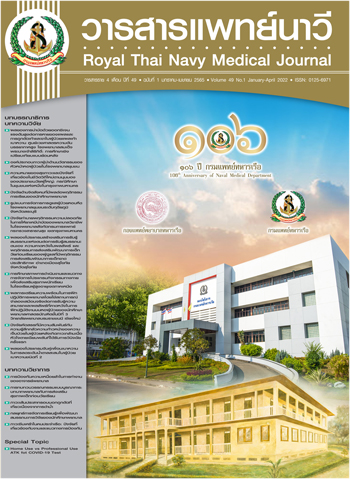Factors Predicting the Safety Behaviors toward Chemotherapy Administration among Registered Nurses in the Hospitals under the Department of Medical Services, Ministry of Public Health in Bangkok
Main Article Content
Abstract
This cross-sectional study aimed to examine factors predicting safety behaviors toward chemotherapy administration among registered nurses working in the hospital under the Department of Medical Services, Ministry of Public Health in Bangkok. The concept of factors influencing safety behaviors was applied to develop a research framework. Subjects were 244 registered nurses from 3 hospitals. Data were collected by questionnaire developed by the researcher. It consisted of five parts including general characteristics; safety environment; knowledge in safety chemotherapy administration, motivation to conduct safety behaviors toward chemotherapy administration and safety behaviors toward chemotherapy administration. Content validity index ranged from 0.82 - 0.98. The reliability ranged from 0.72 - 0.94. Data were analyzed using descriptive and inferential statistics. Mann-Whitney U-test was used to compare differences between two independent groups. Stepwise Multiple Regression Analysis was applied to test the predicting factors.
Overall, the finding indicate that safety behaviors toward chemotherapy administration of registered nurses was at a high level. The timing of chemotherapy administration had a negative correlation with safety behaviors toward chemotherapy administration (r = -0.13, p = 0.048). The chemotherapy training experience (r = 0.07, p = 0.293), safety environment (r = 0.45, p < .001), knowledge in safety chemotherapy administration (r = 0.23, p < .001) and motivation to conduct safety behaviours (r = 0.53, p < .001) were related to safety behaviors toward chemotherapy administration (z = 3.66, r = 0.45, r = 0.23, r = 0.53, respectively). It was found that the motivation to conduct safety behaviours and the safety environment in chemotherapy administration can predict safety behaviors at 31.3% of the probability.
Article Details

This work is licensed under a Creative Commons Attribution-NonCommercial-NoDerivatives 4.0 International License.
References
Maikiaw C, Tamdee D. The effects of clinical nursing practice guideline to prevent oral mucositis among cancer patients received chemotherapy. Nursing Journal 2010;37(1):86-95. (in Thai).
Polovich M. Developing a hazardous drug safe-handling program. Community Oncology 2005;2(5):403-5.
Vollono C, Badoni G, Petrelli G. Risk perception and self assessment of exposure to antineoplastic agents in a group of nurses and pharmacists. G Ital Med Lav Ergon 2002;24(1):49-55.
Skov T, Maarup B, Olsen J, Rørth M, Winthereik H, Lynge E. Leukaemia and reproductive outcome among nurses handling antineoplastic drugs. Br J Ind Med 1992;49(12):855-61.
Krstev S, Perunicić B, Vidaković A. Work practice and some adverse health effects in nurses handling antineoplastic drugs. Med Lav 2003;94(5):432-9.
Thailand Nursing and Midwifery Council. Announcement of the Thailand Nursing and Midwifery Council about prohibition do not give drugs or solutions intravenously. Royal Thai Government Gazzette B.E.2551, 125 (Session No.4ง): 103-4. (7 January B.E.2551). (in Thai).
Hengpraprom S, Kulwanvijit N, Jiamjarasrangsi W. Investigation of safety precautions of healthcare workers in handling antineoplastic drugs at King Chulalongkorn Memorial Hospital. Chula Med J 2006;50(5):319-30.
Najuang N. Factors associated with occupational exposure to chemotherapeutic drugs of personel in Onco wards. [Master’s Thesis, Faculty of Medicine]. Srinakharinwirot University; 2012. (in Thai).
Silpasuwan P. Occupational health nursing: concepts and practice. 3rd ed. Bangkok: Danex Intercorporation; 2015. (in Thai).
Thetkhathuek A. Occupational health and safety. 3rd ed. Bangkok: Odean Store; 2008. (in Thai).
Yoosook W. Occupational health safety and environments. 2nd ed. Bangkok: Nam Akson Printing House; 2011. (in Thai).
Jirapongsuwan A. Work environment and health risk: principles and application for occupational health nursing. Bangkok: Danex Intercorporation; 2018. (in Thai).
Banchuen K. Safety and pollution control. Nonthaburi: SSO Books; 2003. (in Thai).
Neal A, Griffin MA, Hart PM. The impact of organizational climate on safety climate and individual behavior. Safety Science 2000;34(1-3):99-109.
Bloom BS, editor. Taxonomy of educational objective, handbook I: the cognitive domain. New York: David McKay; 1956.
Boonbumroe S. Work safety behaviors of nurse in Maharat Nakhon Ratchasima hospital, Nakhon Ratchasima. The Journal of Boromarajonani College of Nursing, Nakhonratchasima 2014;20(2):82-92. (in Thai).
Bunrodrux J, Khumyu A, Wongsuttitham S. Factors predicting patient safety competence of professional nurse in community hospitals, Chonburi province. Royal Thai Navy Medical Journal 2019;46(3):552-65. (in Thai).
Probst TM, Brubaker TL. The effect of job insecurity on employee safety outcomes: cross-sectional and longitudinal explorations. J Occup Health Psychol 2001;6(2):139-59.
Pound R. Employees behaving safety in 2009. [Internet]. [cited 2016 November 15]. Available from: http://www. Apbusinesscontact.com/ hr-pb_4/health-employees.aspx.

